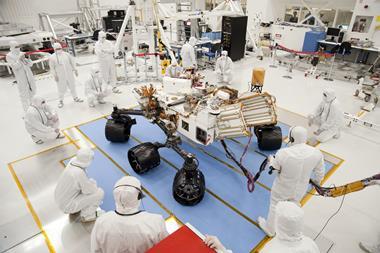Gas-phase spectroscopy on large molecules confirms their structure
The first infrared (IR) spectroscopic investigation of a ’seriously large’ gas phase protein has been completed.
IR spectroscopic studies on proteins have traditionally been carried out on solutions. Scientists have long wanted to carry out similar investigations in the gas phase because this gives fundamental information about the protein without the solvent causing any environmental effects. In the gas phase it is also easy to resolve and isolate different charged states of a molecule - something that can’t be done in solution and which therefore offers entirely new and unique information about a protein.
Previously direct IR absorption of gas-phase ions has not been feasible, due to the limited number of ions (typically 106) that can be conveniently prepared, purified, and trapped for optical interrogation.
Gert von Helden from the Max Planck Gesellschaft Berlin, Germany, and colleagues from the US and the Netherlands have now overcome this problem by means of multiphoton dissociation using the free-electron laser facility FELIX at the Foundation for Fundamental Research on Matter Institute, in Rijnhuizen, the Netherlands.
Von Helden and his colleagues have obtained the first mid-IR action spectrum of a gas-phase protein (cytochrome c), and have found that it shows the same features of amide I and amide II as the solution spectrum. This provides the most direct evidence to date of the inherent stability of protein structure in the absence of any solvent water molecules.
Excited by the implications of the work, Alan Marshall, part of the team from the National High Magnetic Field Laboratory in Florida, US, comments: ’It will now be possible to determine not only intrinsic structures of peptides and proteins (zwitterions, salt bridges, effect of charge state on conformation), but also to probe the nature of binding of metal ions and drugs, as well as protein:protein complexes’. John Simons, an expert on gas phase biomolecules from Oxford University, UK, agrees with the significance of the work, commenting ’the authors should be congratulated on a considerable experimental achievement’.
Experimentalists are now waiting for theorists to catch up before the spectra of other big molecular ions can be interpreted.
More calculations about molecular oscillations are needed, and as von Helden says, ’such calculations are currently difficult for molecules with more than about 100 atoms because of the non-linear scaling of the computational costs with system size. Thus, access to experimental IR spectra of large molecules will necessarily drive the improvement of the molecular modelling algorithms’.
Philip Earis
References
<MAN>b502322j</MAN>






No comments yet